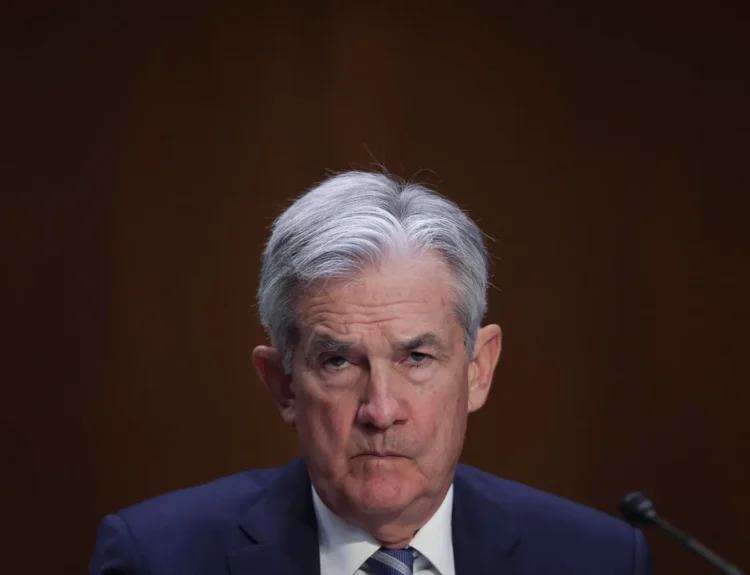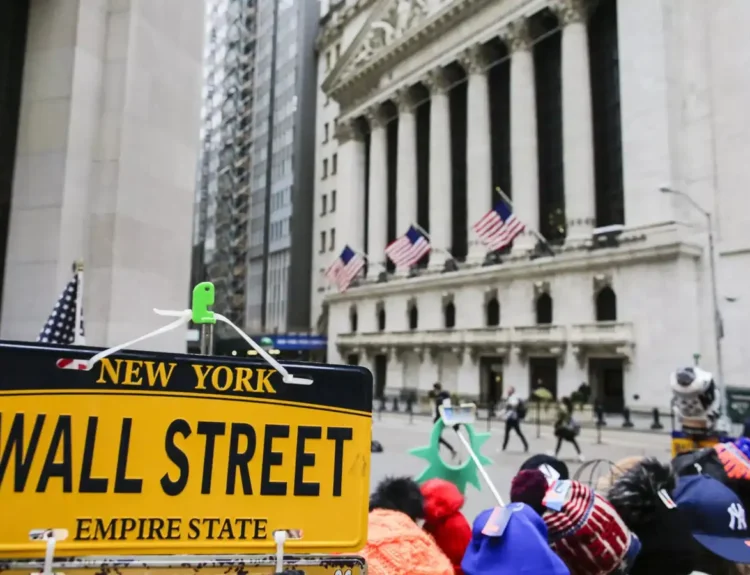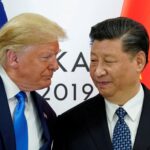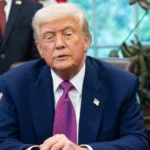On May 12, 2025, President Donald J. Trump signed one of the most aggressive healthcare executive orders in modern U.S. history. The order aims to cut the prices of prescription drugs and pharmaceutical products by 30% to 80%, with immediate effect in certain government programs like Medicare. Trump’s statement was delivered during a press conference at the White House and quickly sent shockwaves across both the healthcare and financial markets.
Trump declared: “Starting today, the United States will no longer subsidize the healthcare of foreign countries… and we’ll no longer tolerate profiteering and price gouging from Big Pharma.”
He specifically criticised the long-standing pricing model that allowed U.S. consumers to pay five to ten times more than patients in other developed countries for the exact same drugs, often manufactured in the very same facilities.
“Prescription Drug and Pharmaceutical prices will be REDUCED, almost immediately, by 30% to 80%… Our Country will finally be treated fairly.”
“The United States will adopt a Most Favored Nation’s Policy whereby we will pay the same price as the country that pays the least anywhere in the world.”
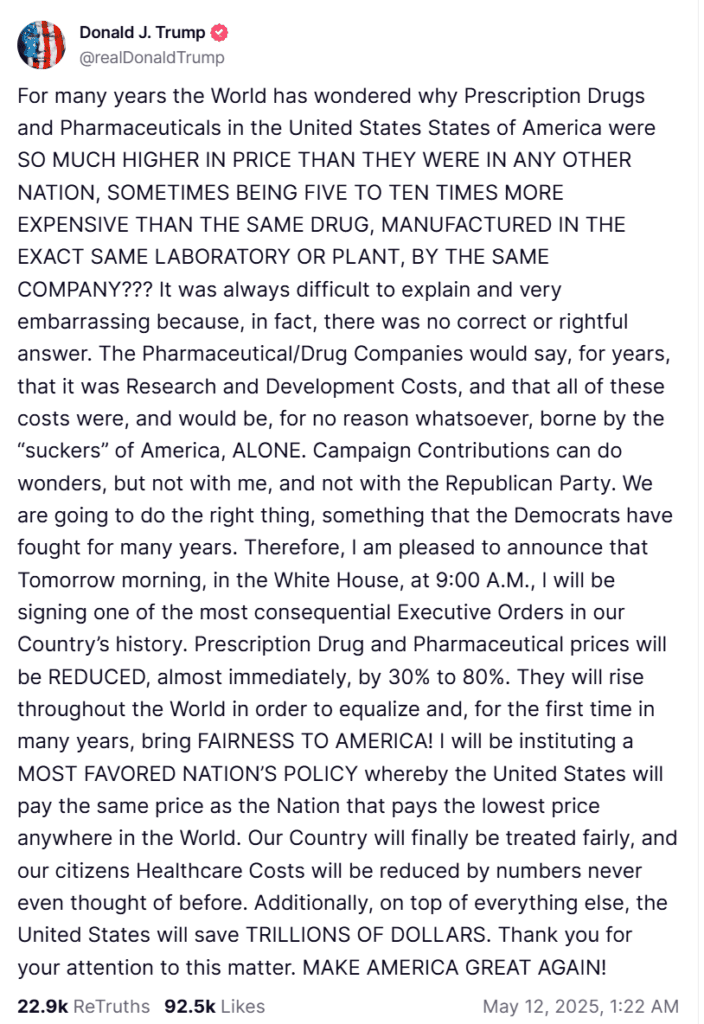
Key Measures in the Executive Order
The order introduces a set of transformative healthcare pricing reforms:
- The U.S. will benchmark its drug prices to the lowest price charged in any other developed nation — a “Most Favored Nation” pricing strategy.
- This will apply initially to Medicare, with expansion into broader markets in phases.
- Pharmaceutical companies are given 30 days to negotiate reduced prices voluntarily, or face enforcement actions that may include:
- Revocation of FDA approvals for price-gouging drugs
- Expanded access to imported alternatives from lower-cost countries
- A complete overhaul of pharmacy benefit manager (PBM) structures, eliminating the “middlemen”
A senior White House official clarified that the first category of drugs being targeted includes weight-loss medications, cancer treatments, and chronic disease therapies like asthma drugs, all of which have seen extreme pricing discrepancies in the U.S. compared to international markets.
Immediate Impact on Stocks
Following the announcement, pharmaceutical and healthcare-related stocks fell sharply, as investors began pricing in long-term margin compression, global pricing parity, and uncertainty in R&D funding models.
Stock Market Reactions:
- Pharmacy Benefit Managers (PBMs):
- Shares of CVS Health ($CVS), UnitedHealth Group ($UNH), and Cigna ($CI) declined, with losses ranging from 3% to 6% intraday. These companies have built extensive revenue streams on rebate-driven pricing structures that are now directly in the administration’s crosshairs.
- Trump explicitly mentioned that the new policy would “cut out the middleman” — a clear reference to PBMs.
- Branded Drug Makers:
- Eli Lilly ($LLY), Novo Nordisk ($NVO), Pfizer ($PFE), and Merck ($MRK) saw immediate downward pressure due to their heavy reliance on international sales and high-margin specialty drugs. These firms price drugs like Ozempic, Zepbound, Keytruda, and Wegovy far higher in the U.S. than in Europe or Asia.
- Stocks like Pacira BioSciences ($PCRX), Bausch Health ($BHC), and Collegium Pharma ($COLL) were also affected due to their exposure to pain management and branded specialty medications with minimal global pricing justification.
- Generic Manufacturers:
- Firms such as Amneal Pharmaceuticals ($AMRX) and ANI Pharmaceuticals ($ANIP) remained relatively stable, as their low-cost generic portfolios are not the immediate focus of the administration’s pricing overhaul — though officials have indicated they may enter future rounds of review.
Why Certain Drug Categories Are Targeted
White House officials and analysts have confirmed that the executive order will prioritize high-cost categories where pricing disparities are most extreme and global pricing data is readily available. Here’s a breakdown of what’s likely next:
| Category | Rationale for Targeting | Likely Affected Companies |
|---|---|---|
| Weight-loss drugs | Skyrocketing demand in the U.S.; priced 3–5x higher than in EU | $LLY (Zepbound), $NVO (Wegovy, Ozempic) |
| Cancer treatments | Widest pricing gaps globally; critical for Medicare | $PFE, $MRK, $BMY, $AZN |
| Asthma & COPD meds | Lifetime use meds often costlier in U.S. by 4x | $GSK, $SNY, $AZN |
| Diabetes/Insulin | Humanitarian focus; years of public pressure over pricing | $LLY, $NVO, $SNY |
| Pain medications | Specialty opioids and extended-release drugs overcharged in U.S. | $COLL, $PCRX |
Truist note: “Branded medications with significant ex-U.S. sales are most at risk. Generic firms may avoid initial impact, but could enter future pricing negotiations.”
Global Impact: Regions and Repercussions
This U.S. policy shift could reshape global pharmaceutical pricing models:
- Europe & Asia: If the U.S. ties its prices to EU rates, pharma companies may be forced to raise prices abroad to preserve margins. Bloomberg reports that pharma stocks in Japan and South Korea slid after Trump’s announcement.
- India & China: As major generic exporters, these countries could benefit from expanded U.S. imports if price targets aren’t met domestically.
- Canada & UK: Potential shortages may arise if the U.S. begins large-scale purchasing from lower-priced markets.
Quotes & Political Reactions
Trump: “It was always difficult to explain… how the same drug made in the same factory could cost 10x more here. The answer: lobbying, middlemen, and a system that treated American citizens like suckers.”
Leavitt (HHS official): “President Trump is signing an executive order today that is going to … reduce the cost of drugs in this country by more than half at least.”
White House Statement: “Commerce, USTR, and FDA will coordinate on import rule expansions, anti-foreign suppression investigations, and direct-to-consumer pilot programs.”
What Comes Next
In the Next 30 Days:
- HHS to release official pricing benchmarks and drug list
- Pharma companies expected to negotiate or face enforcement
- WH to launch studies on DTC (direct-to-consumer) models
Market Watch Going Forward:
- Expect new volatility in healthcare, biotech, and PBM sectors
- Pressure likely to expand to EU and Asian pharma equities
- Long-term margins at risk for branded pharma across all regions
Disclosure: This article does not represent investment advice. The content and materials featured on this page are for educational purposes only.
Related:
US and China announce deal to cut reciprocal tariffs for 90 days
Zelensky Tells Putin to Show Up in Turkey for Talks After Trump Pushes for Meeting
US and China Strike Trade Deal After Breakthrough Talks
BlackRock CEO Larry Fink Predicts Bitcoin to Hit $500K in 5–10 Years
Global Savings Glut: How Surplus Savings and Investment Imbalances Are Reshaping World Economy
China’s Billions in Military Tech Face First Major Test in India-Pakistan Conflict
Google Faces Crackdown and Stock Crash — But Is It a Long-Term Opportunity?
Tariff Trouble in Hollywood: Studios brace for new policy as box office struggles




